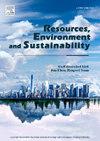面向疫情后可持续发展的中国生态资源流动时空格局与驱动力研究
IF 12.4
Q1 ENVIRONMENTAL SCIENCES
引用次数: 0
摘要
疫情后时代,以国内市场为主体的中国,标志着区域间贸易取代国际贸易成为区域可持续发展的核心驱动力的转变。因此,对中国区域间自然资源流动的科学认识至关重要。本文采用净初级生产的人为占用(HANPP)框架构建指标,扩展了多区域投入产出(MRIO)表。然后利用这个表来探讨中国生态资源的省际流动模式及其决定因素。结果表明:①中国生态资源流动以西部内陆地区向东部沿海地区转移为主,但省际间的相互作用格局日趋复杂;(2)农业生产强度、生态资源禀赋和地理距离是影响生态资源流动模式的一致且显著的因素。(3) 2012 - 2017年,生态资源生产或消费结构调整是生态资源净流量变化的主要驱动因素。近一半省份的生产结构发生变化,导致经济发展与生态资源脱钩。与此同时,经济发达省份的消费结构变化使区域消费模式朝着更可持续的方向发展。这些见解可为中国区域可持续发展的区域间生态资源动员路径整合提供科学支持。本文章由计算机程序翻译,如有差异,请以英文原文为准。

Exploring the spatio-temporal patterns and driving forces of ecological resource flows in China for post-epidemic sustainable development
In the post-epidemic era, the domestic market as the mainstay in China is signifying a shift whereby interregional trade supersedes international trade as the pivotal driver of regional sustainable development. Thus, the scientific understanding of interregional natural resource flows within China is crucial. This study refers to the human appropriation of net primary production (HANPP) framework to construct indicators to extend the multi-regional input–output (MRIO) table. This table is then used to explore the interprovincial flow patterns and their determinants of ecological resources in China. The results show that: (1) Ecological resource flow in China predominantly moves from western inland regions to eastern coastal regions, yet the interplay among provinces is evolving into a more intricate pattern. (2) Agricultural production intensity, ecological resource endowment, and geographic distance are consistent and significant factors influencing ecological resource flow patterns. (3) Structural adjustments in ecological resource production or consumption primarily drove changes in net ecological resource flows from 2012 to 2017. Production structural changes in nearly half of the provinces initiated a decoupling of economic development from ecological resources. Meanwhile, consumption structural changes in economically developed provinces steered regional consumption patterns towards greater sustainability. These insights can offer scientific support for the integration of interregional ecological resource mobilization pathways for regional sustainable development in China.
求助全文
通过发布文献求助,成功后即可免费获取论文全文。
去求助
来源期刊

Resources Environment and Sustainability
Environmental Science-Environmental Science (miscellaneous)
CiteScore
15.10
自引率
0.00%
发文量
41
审稿时长
33 days
 求助内容:
求助内容: 应助结果提醒方式:
应助结果提醒方式:


